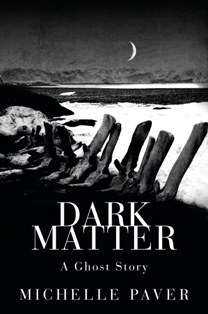
First published in October 2010, Malawi born author Michelle Paver’s novel ‘Dark Matter’ was the product of much first-hand research into Spitsbergen and the desolate winter landscape of the Svalbard archipelago in Norway.
DLS Synopsis:
If he was honest with himself, when Jack Miller, a relatively poor and lonely Londoner, agreed to go on a scientific expedition with a small team of researchers to the desolate island of Gruhuken, located in the Svalbard archipelago of Norway, he had no real idea of what he was getting himself into. Nevertheless, it was 1937 and the team was now all set to depart for Gruhuken - Miller (in charge of communications), together with Gus Balfour (biologist and expedition leader), Algernon Carlisle (chief huntsman, dog-driver and geologist) and Hugo Charteris-Black (glaciologist).
However, their photographer and medico, Teddy Wintringham, had recently been informed of his father’s death, and so that left the team short of a medico. Nevertheless after a short discussion, they decide to go on with the expedition without Teddy. But their bad luck doesn’t stop there, and soon enough during their voyage to Norway, Hugo Charteris-Black breaks his leg on a coil of rope on deck and is rushed to nearby Longyearbyen for medical treatment. Of course, he is now off the team.
Down to a band of just three, they continue their journey on board the 90-foot sealing sloop ‘The Isbjorn’, piloted by Skipper Eriksson and his seaworthy Scandinavian crew.
Arriving at Gruhuken, the trio set up camp, building a cabin for them to spend the next year within – otherwise alone on the desolate Arctic island. Eriksson fears for the small band of scientists. Not only does the winter bring a constant polar night that engulfs the land in darkness for months on end. More than this, the sea freezes during these subzero months, making escape from the island impossible. But there is something even more unsettling that troubles this hard-worn sailor. Gruhuken holds a dark secret that is never spoken of. A secret that none of the three scientists know anything about, or if they were told, would believe for a second. For against what they have been told, Gruhuken is not entirely uninhabited...
DLS Review:
From the outset, the novel portrays itself in a similar manner to the popular ghost stories of the period for which it has been set, with a distinctive feel to the story baring a fond resemblance to the likes of Algernon Blackwood (probably the inspiration behind Algernon Carlisle’s name), E. F. Benson, William Hodge Hodgson, M. R. James, and Ambrose Bierce’s work. Indeed from when Miller is alone on the island within the cabin which they built, numerous similarities and inspirations come to mind from the likes of Guy de Maupassant’s short story ‘The Inn’ (1890).
Paver successfully paints a vivid atmosphere of underlying oppression and such a stark bleakness to the whole landscape. The author’s prose is (even in diary form) often very selective, carefully setting down exactly the atmosphere that is required for the setting of the novel.
The characterisation is varied, with obvious depth of development put into that of the lead character and narrator – Jack Miller. Miller’s relationship with Gus Balfour is an intriguing one, very much open to debate on the levels of affection. Perhaps unbeknown to Miller himself, there may well be sexual feelings involved? Perhaps just a fondness for the other man, exaggerated somewhat by the circumstances they are within. Paver leaves this aspect open for the reader to draw whatever conclusions they want.
Once again, further dimensions to our lead character are unearthed with his change of heart towards the husky dogs that have been brought along with the team. This gradual changing of attitude only goes to strengthen the relationship that the reader has between themselves and the character.
Although the novel strives hard to create a haunting atmosphere, ultimately to grip and chill the reader, Paver falls somewhat short on each and every attempt. Yes there is a curiously dark atmosphere created around the island. However, from the very first glimpses of ‘the ghostly figure’, Paver fails to really portray the deep-routed malevolence that is required. Shock value for the sake of shocking is not required in this novel, and indeed Paver steers well clear of this. But what could have added so much more of a chilling punch to the tale would be to inject more to the harsh visions that are projected onto the reader via Miller’s disturbed recollections. Purely relying on a suggestive angle for the hard-hitting moments, instead of really depicting the scene, does not always work. The reader’s imagination should certainly be tapped into and allowed to escalate the threat for themselves; after all, nothing is more scary that an individual’s worst fears imagined. But the overuse and over reliance on this does start to dilute the horror-factor of the novel somewhat.
The finale and ending is satisfyingly downbeat and appropriately unceremonious. Paver knows the audience she is writing to and how to keep the novel from falling into the trap of becoming clichéd or predictable.
All in all, the novel hits the creepy tone from early on and maintains it throughout. Although the tale never really chills the spine with any stand-out shock moments (expect perhaps one, but I certainly won’t ruin it for you), it does manage to successfully keep the attention of the reader with the almost palpable dark atmosphere. A good creepy ghost story with an utterly inspired premise, which given more of a push, could have been so much more haunting.
The novel runs for a total of 212 pages.
© DLS Reviews






